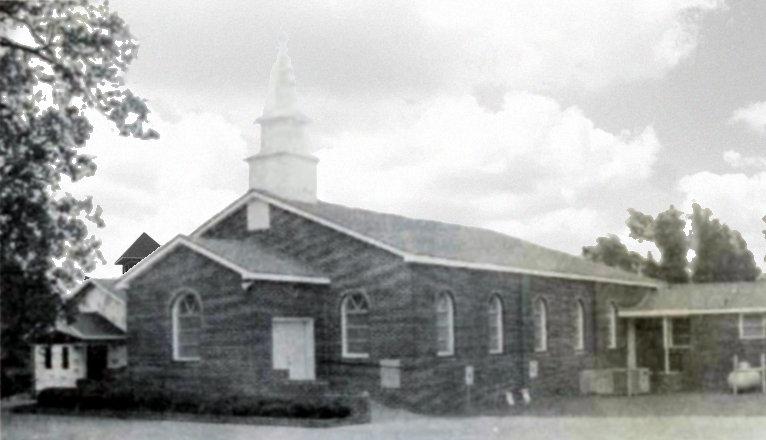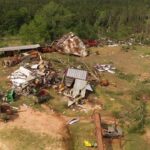
By Johnnie M. Anderson
Mount Sinai Baptist Church is located about three miles west of Newville, Alabama. The church was organized as a slave congregation in 1659. Up until that time the slaves in that area met with their owners’ families for worship.
The first church was a ‘brush arbor’ located somewhere between present-day Concord Church and Kirkland Crossroads on property of Henry Hollis, a white land owner. Later a log cabin church was built, complete with a bell tower, on and donated by the Brackin Family. The church and cemetery are presently located on this property.
The church bell was very important to the community. When there was a crisis in the neighborhood, the church sexton was notified. He would then go to the church, ring the bell, and see that someone was posted there to give out information as to what had happened and the need for help. In case of death, help would be needed to prepare the body for burial, since embalming was not a general practice until the 1930s. Also, men in the community met at a set time to dig the grave.
About 1915, black carpenters from Dothan and Ozark were contracted to remodel the church. The logs were replaced with pine siding which was then painted white. The church was set up about 3 feet on stone and brick pillars to allow the air to circulate under the building to help keep it cool. The building had glass windows that could be opened, also as a part of the cooling system. The church was lighted with hanging and mounted gasoline lamps, which had delicate wicks. The lamps had to be lighted ahead of time, and have air pumped into the base of the lamps containing the fuel to create a vapor that flowed through the wick and burned to provide a very bright light. Operating the lighting system was also a duty of the sexton He was paid a token salary for his services. The church was heated by wood or coal burning cast-iron heaters.
The landowners in the area were said to be from England. They had migrated to the territory to participate in the new country’s westward expansion. They acquired land and brought in slaves from the markets In Virginia and South Carolina for labor to open up the land and establish farms. Three families, the Kirklands, Brackins, and Hollises settled in lower Henry County. It seems that they traded slaves among themselves.
One slave couple, Liddie and Spencer Kirkland had a family of 9 children – six sons and three daughters. Liddie told her children, that she had been bought in a market in Virginia and with a group of other slaves walked the full distance from Virginia, camping along the way. Spencer had been brought in from South Carolina. Some of their children were traded to some of the Kirklands, Brackins, and Hollises families in the area. Most of these children remained in their home territory, but one son was sold to a family named Speight who moved him to north Florida, around Quincy. He was allowed to return at intervals to visit his relatives; however he was not able to bring his own family. After he grew old and passed away, his descendants drifted further into Florida, and were forever disconnected from the original family.
After emancipation, slaves took the surnames of their owners. Because local families had traded slaves among themselves, close family members often ended up with different last names. Liddie and Spencer, from the beginning, taught their offspring that the names Kirkland, Brackin, and Hollis were the same name so far as family was concerned.
Liddie and Spencer and their descendants were the original members of Mt. Sinai Baptist Church and a majority of the present membership is somehow connected to this family. The first recorded deacons of the church were Jordan Kirkland. Ransom Hollis, and Tommy Trawick. Ransom Hollis was the son of Henry Hollis and the nephew of Warren Hollis. Tommy Trawick was a brother-in-law to Warren and Henry Hollis. Silvester Kirkland, another brother, is recorded as the first Sunday school teacher.
The end of slavery signaled a new beginning for the church and to celebrate this new era a family reunion and Sacred Harp Sing was organized. Since 1863 this celebration has been observed on the 4th Sunday in May, and has convened continuously since that time except for one or two occasions due to extremely inclement weather or illness.
Last year was one of those rare occasions. Moses Brackin, who is in his 88th year, was recovering from a bout with the flu. He is the convener, and most of the singers are quite elderly, and depend on Moses to conduct the program. It was decided to not meet last year, however the community is becoming involved and plans are in the making to reorganize and continue the celebration.
Over the years Mt. Sinai has been fortunate in having had good leadership. One of the early pastors was a Mr. Brackin, a member of one of the landowners’ family. Rev. Thomas Bellinger, a graduate of Hampton University, served two separate terms for a total of 37 years, between 1912 and 1950.
A long with the spiritual development of his flock, he supported the economic, personal and Intellectual development of the people.
Rev Jordan Davis, also a Hampton graduate, served as pastor during the absence of Rev Bellinger, who served as Dean of Religion at Selma University in Selma, Alabama.
After Rev BelIinger retired, Rev. Brown became pastor of the church. Rev Eddie Thomas, the present pastor, came to the church, as a musician while Rev. Brown was pastor.
The church assisted young Mr. Thomas in attending college, and upon completion of his education, he became pastor of the church in 1974. Under his leadership the church has been remodeled into an impressive brick structure with all modern facilities. A spacious fellowship hall expansion is currently under construction.
(Mrs. Anderson is a retired educator and resides in Montgomery, Alabama)



